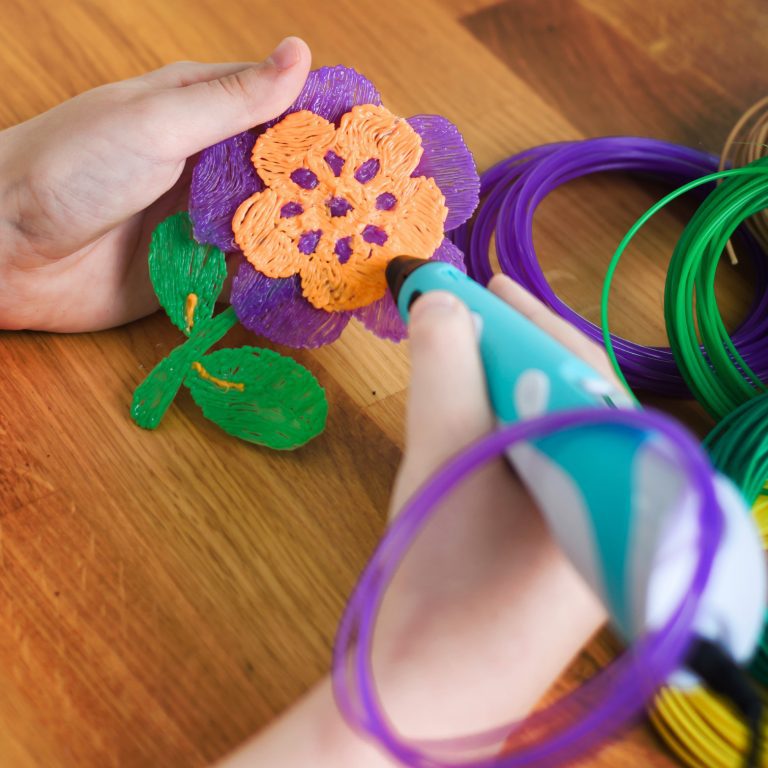Table of Contents:
A thoughtful choice of toys and creative tools is like a parenting cornerstone. We want our children to play creatively and safely. Have you ever dreamed of drawing three-dimensional objects in the air? Here is a 3D magic pen – for everyone who wants to create 3D drawings at a really low cost.
Drawing and children’s development
One of the first things a child learns at the appropriate stage of motor development is to pick up a pencil and start drawing. Usually this ability develops around the age of 3 – works of art resembling a human figure or a house begin to emerge. A whole new stage of abstract thinking begins in a young person.
Children are not always able to express themselves through words and actions. Sometimes even adults learn to do this. Drawing is an important form of communication. Through drawing you can gain insight into the child’s thoughts and feelings. Of course, this works both ways – the ability to express feelings, known as emotional intelligence, is also the ability to use one’s own emotions and deal with the emotional states of others. New technologies are becoming increasingly accessible to children and their parents and bring with them new ways of learning important creative and interpersonal skills.
3D pen for a child – fun and education in the world of imagination
Perhaps for many of you, a pen is not fundamentally associated with drawing. 3D pens are also interchangeably referred to as 3D printing pens – a tool in turn clearly associated with calligraphy. However, when we look at the amazing, colourful and three-dimensional shapes that 3D pens for children can bring with them, the association of a combination of crayons and plasticine comes to mind. A 3D model is a completely different dimension of expression than a drawing created in 2D on paper. We have all this without the light of a phone or tablet screen, and we know that our children love these devices, and deciding how to use them in a sensible way by children causes a lot of trouble for parents.
The alternative that has all the advantages is the 3D pen. It makes it possible to create three-dimensional drawings in the air using an appropriate material in the form of a filament. It can be used not only by children and teenagers, but also designers, artists and architects. The 3D pen uses the same technology as the 3D printer, but allows printing during the writing process.
Drawing in 3D – a higher level of creation
From small scribbles to a masterpiece that takes pride of place on the fridge door, drawing improves children’s fine motor skills and expands their imagination from an early age. Starting to learn to draw as early as possible will help your child to improve hand-eye coordination as well as exercising their muscles.
It is worth remembering that we can develop talent in children really early on, and they simply get an easier start in life as a result. It may sound simple, but that’s the way it is – you never know which of the skills your children acquire early on will want to turn into a lifelong passion or profession at any stage of their lives.
Choosing a 3D pen for your child? Here’s what you should know before you buy
Okay, the gadget looks great. However, these are not at all as simple devices as you might think and with all this information about 3D pens for kids, we might feel a little overwhelmed. Let’s try to simplify the search a bit. Here are the most important information and tips for using this type of device:
- Many 3D pens require power from a cord.
- 3D drawing is multi-coloured and you can change the cartridge (filament) at any time.
- For ease of use, individual pieces of artwork can be painted on paper or cardboard, then peeled off and joined together using the 3D pen. The hot dose of filament will melt into the two pieces joining them into one, like glue, which dries instantly.
- 3D pens usually have various modes, such as fast, normal and accurate, like the Polaroid Play 3D+, which is designed for children over 14.
- The 3D pen has a heated tip, in the case of the AZPEN Azure Film 3D pen it is in the range of 160°C – 230°C – little ones should use it under the watchful eye of a guardian.
- A 3D pen is only as good as the filament it uses. Most can work with at least two types of material: the more brittle ABS and the softer PLA.
- Some 3D pens can go even further and work with materials made from wood, algae or nylon – the less common filaments usually cost a little more.
- More advanced 3D pens have an LCD display (Sunlu SL-300A).
How useful was this post?
Click on a star to rate it!
Average rating 0 / 5. Vote count: 0
No votes so far! Be the first to rate this post.





















